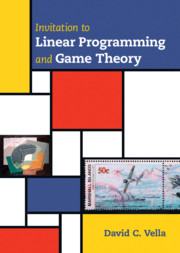Book contents
- Frontmatter
- Contents
- Preface
- Acknowledgements
- 1 Preliminaries
- 2 Matrix Algebra
- 3 Graphical Linear Programming
- 4 Sensitivity Analysis and Duality
- 5 The Simplex Algorithm
- 6 Game Theory
- 7 More Game Theory
- 8 Sensitivity Analysis, Ordinal Games, and n-Person Games
- 9 More Linear Programming
- Appendix A Rapid Review of Sets and Probability
- References
- Index
6 - Game Theory
Published online by Cambridge University Press: 11 March 2021
- Frontmatter
- Contents
- Preface
- Acknowledgements
- 1 Preliminaries
- 2 Matrix Algebra
- 3 Graphical Linear Programming
- 4 Sensitivity Analysis and Duality
- 5 The Simplex Algorithm
- 6 Game Theory
- 7 More Game Theory
- 8 Sensitivity Analysis, Ordinal Games, and n-Person Games
- 9 More Linear Programming
- Appendix A Rapid Review of Sets and Probability
- References
- Index
Summary
We introduce the notion of a mathematical game. We give examples and classify them into various types, such as two-person games vs. n-person games (where n > 2), and zero-sum vs. constant-sum vs. variable-sum games. We carefully delineate the assumptions under which we operate in game theory. We illustrate how two-person games can be described by payoff matrices or by game trees. Using examples, including an analysis of the Battle of the Bismarck Sea from World War II, we develop the notions of a strategy, dominant strategy, and Nash equilibrium point of a game. Specializing to constant-sum games, we show the equivalence between Nash equilibrium and saddle point of a payoff matrix. We then consider games where the payoff matrix has no saddle point and develop the notion of a mixed strategy, after a quick review of some basic probability notions. Finally, we introduce the minimax theorem, which states that all constant-sum games have an optimal solution, and give a novel proof of the theorem in case the payoff matrix is 2 x 2.
Keywords
Information
- Type
- Chapter
- Information
- Invitation to Linear Programming and Game Theory , pp. 242 - 300Publisher: Cambridge University PressPrint publication year: 2021
